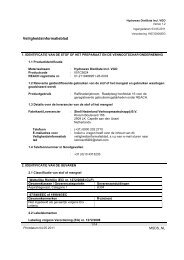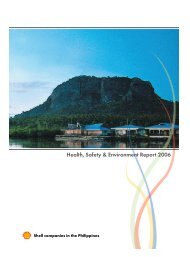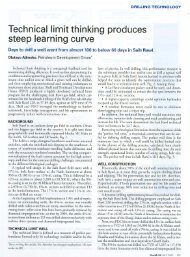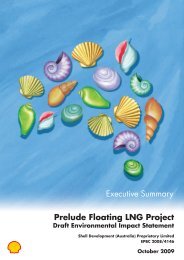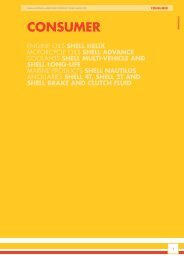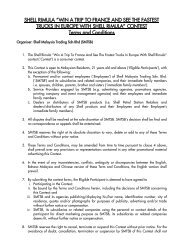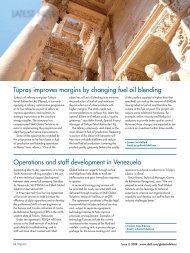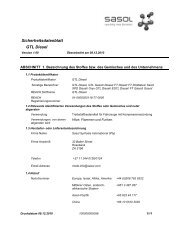Safety Data Sheet - Shell
Safety Data Sheet - Shell
Safety Data Sheet - Shell
Create successful ePaper yourself
Turn your PDF publications into a flip-book with our unique Google optimized e-Paper software.
<strong>Safety</strong> <strong>Data</strong> <strong>Sheet</strong><br />
Protective Equipment &<br />
Precautions for Fire<br />
Fighters<br />
<strong>Shell</strong> GTL Distillate<br />
Version 1.5<br />
Effective Date 03.11.2011<br />
: Wear full protective clothing and self-contained breathing<br />
apparatus.<br />
Additional Advice : Keep adjacent containers cool by spraying with water.<br />
6. ACCIDENTAL RELEASE MEASURES<br />
Avoid contact with spilled or released material. For guidance on selection of personal protective<br />
equipment see Chapter 8 of this Material <strong>Safety</strong> <strong>Data</strong> <strong>Sheet</strong>. See Chapter 13 for information on<br />
disposal. Observe the relevant local and international regulations. Evacuate the area of all nonessential<br />
personnel. Ventilate contaminated area thoroughly.<br />
Personal Precautions,<br />
Protective Equipment and<br />
Emergency Procedures<br />
Environmental<br />
Precautions<br />
Methods and Material for<br />
Containment and Clean<br />
Up<br />
: Do not breathe fumes, vapour. Do not operate electrical<br />
equipment.<br />
: Shut off leaks, if possible without personal risks. Remove all<br />
possible sources of ignition in the surrounding area. Use<br />
appropriate containment (of product and fire fighting water) to<br />
avoid environmental contamination. Prevent from spreading or<br />
entering drains, ditches or rivers by using sand, earth, or other<br />
appropriate barriers. Attempt to disperse the vapour or to direct<br />
its flow to a safe location for example by using fog sprays.<br />
Take precautionary measures against static discharge. Ensure<br />
electrical continuity by bonding and grounding (earthing) all<br />
equipment.<br />
: For small liquid spills (< 1 drum), transfer by mechanical means<br />
to a labelled, sealable container for product recovery or safe<br />
disposal. Allow residues to evaporate or soak up with an<br />
appropriate absorbent material and dispose of safely. Remove<br />
contaminated soil and dispose of safely.<br />
For large liquid spills (> 1 drum), transfer by mechanical means<br />
such as vacuum truck to a salvage tank for recovery or safe<br />
disposal. Do not flush away residues with water. Retain as<br />
contaminated waste. Allow residues to evaporate or soak up<br />
with an appropriate absorbent material and dispose of safely.<br />
Remove contaminated soil and dispose of safely. Shovel into a<br />
suitable clearly marked container for disposal or reclamation in<br />
accordance with local regulations.<br />
Additional Advice : Notify authorities if any exposure to the general public or the<br />
environment occurs or is likely to occur. Local authorities<br />
should be advised if significant spillages cannot be contained.<br />
Maritime spillages should be dealt with using a Shipboard Oil<br />
Pollution Emergency Plan (SOPEP), as required by MARPOL<br />
Annex 1 Regulation 26.<br />
7. HANDLING AND STORAGE<br />
General Precautions<br />
: Avoid breathing vapours or contact with material. Only use in<br />
well ventilated areas. Wash thoroughly after handling. For<br />
guidance on selection of personal protective equipment see<br />
4/11<br />
Print Date 03.11.2011 000000021991<br />
MSDS_IMO




